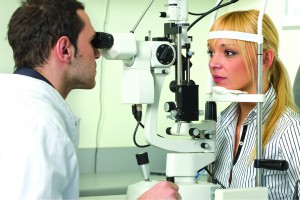By Lauren R. Rosecan, M.D., Ph.D., F.A.C.S.
 The human immunodeficiency virus (HIV) is a virus that causes the body’s immune system to break down. Your immune system fights off illness and infection and is very important for a healthy body.
The human immunodeficiency virus (HIV) is a virus that causes the body’s immune system to break down. Your immune system fights off illness and infection and is very important for a healthy body.
Once HIV is present in the body, it attacks important white blood cells in your immune system called lymphocytes, or T-cells. T-cells identify and destroy invading organisms in the body. Once attached to the T-cell, HIV replicates and destroys the cell. When your body is deprived of enough T-cells, it can become very sick from infections that a healthy person’s immune system would normally fight off, such as colds, flu and other viruses.
What Is AIDS?
AIDS is acquired immune deficiency syndrome, and is caused by HIV. Someone is considered to have AIDS when their immune system is no longer able to keep them healthy. For someone with HIV, the process of the virus destroying T-cells and replicating itself may go on for years. This is why many people infected with HIV do not get sick with AIDS until years later.
How Do You Get HIV?
HIV lives and reproduces in human blood and other body fluids. Someone can become infected with HIV if these infected fluids enter their body.
These fluids can contain high levels of HIV:
• Blood
• Semen
• Pre-seminal fluid
• Breast milk
• Vaginal fluids
• Rectal (anal) mucous
Other body fluids, as well as waste products like feces, urine, vomit, nasal fluid, saliva, sweat and tears, generally don’t have enough HIV in them to infect you, unless blood is present in them.
While HIV can be found in tears of infected people, no cases of AIDS have ever been reported from tear contact. Ophthalmologists (Eye M.D.s) are especially careful about cleaning instruments and lenses that come in contact with tears.
How Does HIV/AIDS Affect the Eye?
Because HIV causes a breakdown of your body’s immune system, all areas of the body are susceptible to infection, including the eye. People with HIV who are otherwise in good health are not likely to experience eye problems related to a suppressed immune system. However, an estimated 70 percent of patients with advanced AIDS experience eye disorders.
AIDS-related eye problems due to a suppressed immune system can include the following:
HIV retinopathy
This is the most common finding in people with AIDS. Small hemorrhages and cotton wool spots (white spots as a result of a blood vessel blockage) are seen in the retina—the light-sensitive tissue lining the back of your eye. It is thought that the HIV virus is directly responsible for these changes to the small blood vessels in the retina.
CMV retinitis
A more serious eye infection that occurs in about 20 to 30 percent of people with AIDS is CMV retinitis. It is caused by a virus called cytomegalovirus (CMV). It usually occurs in people who have more advanced stages of AIDS in which T-cell count is very low. Symptoms include swelling (inflammation) of the retina, bleeding and vision loss. If left undiagnosed and untreated, CMV can cause severe vision loss within a few months.
If you have HIV/AIDS, you should see your ophthalmologist (Eye M.D.) immediately if you experience:
• floating spots or “spider-webs”;
• flashing lights;
• blind spots or blurred vision.
CMV retinitis cannot be cured, but progression of the virus can be slowed with medication.
Detached retina
CMV can sometimes cause detached retina, where the retina pulls away, or detaches, from the back of the eye. A detached retina is a serious problem that causes severe vision loss unless treated. Almost all retinal detachments require detached retina surgery to put the retina back in its proper position.
Kaposi’s sarcoma
Kaposi’s sarcoma is a rare form of cancer that occurs in AIDS patients. This cancer can cause purple-red lesions to form on the eyelids, or a red, fleshy mass to form on the conjunctiva—the thin, filmy membrane that covers the white part of your eye. Kaposi’s sarcoma may look frightening, but it usually does not harm the eye, and can often be treated.
Squamous cell carcinoma of the conjunctiva
This is a tumor of the conjunctiva, the thin membrane that covers the white of the eye. Studies have shown this condition to be related to HIV/AIDS infection, prolonged exposure to sunlight, and infection with the human papilloma virus (HPV).
Increased risk of various eye infections
A number of eye infections, some associated with sexually transmitted diseases and others that are not, may be more common in patients with HIV. Some of these infections may include herpes virus, gonorrhea, Chlamydia, toxoplasmosis, Candida, Pneumocystis, microsporidia, and others. These infections can threaten vision and require treatment by an Eye M.D.
How Are HIV-Related Eye Diseases Treated?
The treatment for HIV-related eye diseases depends upon the particular disease. However, patients who maintain the health of their immune system through antiviral drug treatments are at lower risk of developing HIV-related eye diseases.
It is important for anyone with HIV to undergo routine eye examinations with an ophthalmologist to detect any problems as early as possible.
Lauren R. Rosecan
M.D., Ph.D., F.A.C.S.
The Retina Institute of Florida with four offices
conveniently located in Palm Beach and Martin Counties.
Toll Free Phone Number:
1-800-445-8898
561-832-4411
Check Also
The Mighty Maestro: Bob “Mighty Mite” Toski’s Enduring Legacy at 98
In the warm glow of a spring evening in Delray Beach, Florida, a remarkable celebration …
 South Florida Health and Wellness Magazine Health and Wellness Articles
South Florida Health and Wellness Magazine Health and Wellness Articles




